南开大学光学工程内部课件Sep 28th
合集下载
南开大学光学工程内部课件Sep 7th
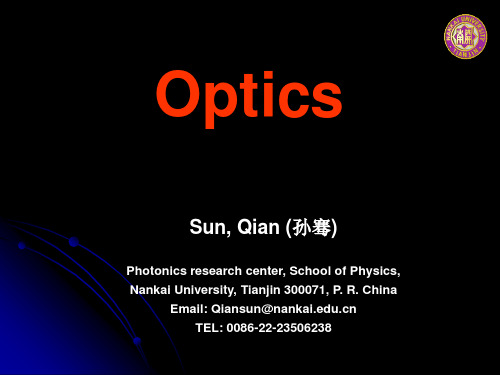
Brief history of optics (cont’ed)
平面镜 (《经下》19/—/42· —) 经:景迎日。说在转。 影子可以由反射(迎)太阳(的光线)形 成。理由在于翻转
经说:景,日之光反烛人,则景在日与人之间。
如果太阳之间
Brief history of optics (cont’ed)
母国光 战元龄著 《光学》 人民教育出版社
参考书目
ftp://202.113.227.137 Username: optics Password: optics-nk
/opt/index/
/course/optics/
《淮南万毕术》,公元前120左右,淮南王刘安及 其门客的著作。记录了用冰制作透镜的方法: “削冰令圆,举以向日,以艾承其影,则火生。” 还记录了潜望镜的雏形:“取大镜高悬,置水盆 于其下,则见四邻矣。”
Brief history of optics (cont’ed)
谭峭《化书》,约公元940年(南 唐)。书中有一段十分有趣的记 录:小人常有四镜。一名圭,一 名珠,一名砥,一名盂。圭视者 大,珠视者小,砥视者正,盂视 者倒。观彼之器,查我之型,由 是无大小,无短长,无妍丑,无 美恶。描述的很有可能是四种透 镜的成像性质。圭是双凹发散透 镜,珠是双凸透镜,砥是平凹透 镜,盂是平凸透镜。
一个受到光照射的人,看起来就好像他在发射出(光线)一样。人的下 部成为(像的)上部,而人的上部成为(像的)下部。人的脚(好像发 出)光在下方被遮蔽(即照到了针孔的下方),(但另一些光线)在上 方成像。人的头(好像发出)光在上方被遮蔽(即照到了针孔的上方), (但另一些光线)在下方成像。在(离开光源、反射体或像)较远或较 近的某个位置上,有一个距激光的点(端)(即针孔),结果像就只被 允许通过聚集之处(库)的光线所形成
南开大学光学工程内部课件Oct 19th
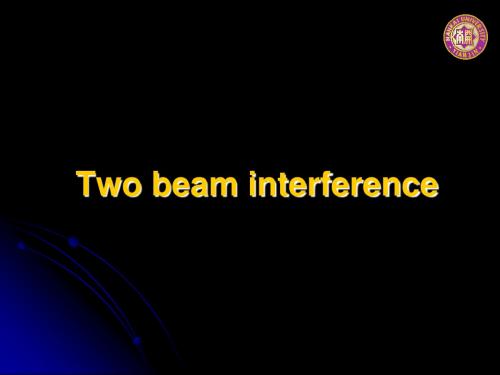
E1 (r , t ) E01 exp i(k1 r t 1 ) E2 (r , t ) E02 exp i(k2 r t 2 ).
Two plane waves meet at P
Superposition of two beams
The transmitted light is incident onto a screen containing two narrow slits
Young’s Double Slit Experiment
The symmetric narrow slits, S1 and S2 act as the two light sources The waves from the two slits come from the same source S0 and therefore are always in phase.
m
= 0, ±1, ±2, …
Interference Equations
Y:measured vertically from the zeroth order maximum Assumptions
L >>d,
d >>λ
y =LtanθLsinθ
I I1 I 2 2 I1I 2 cos(kd sin ) I1 I 2 2 I1I 2 cos(kdy / L)
Other Coherent Sources
Currently, it is much more common to use a laser as a coherent source The laser produces an intense, coherent,
南开大学光学工程内部课件Nov-16th
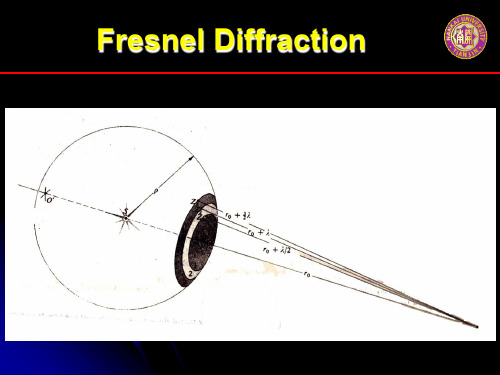
If the primary wave was simply to propagate
from S to P, it is
E
0
e i[t k ( r0 )]
r0
The two equations must be exactly the same. So we introduce a /2 phase difference between the primary wave and the secondary wave to make the two equations so.
dS d 2 ( sin )
Fresnel Dif2 2( r0 )cos
So
dS 2 rdr. Constant!!! r0
We have
El
(1)l 1
2Kl A r0
equation (a) becomes
E E1 Em
2
2
Fresnel Diffraction
From equation (b) we have
E
E1
E2 2
E m 1 2
Em
Since K() goes from 1 to 0 over a great many zones, we can neglect any variation between adjacent zones, i.e. │E1│= │E2│, │Em-1│= │Em│. So
Em 2
)
Em 2
(a)
or
E
E1
E2 2
(
E2 2
E3
E4 2
南开大学光学工程内部课件Lecture 2
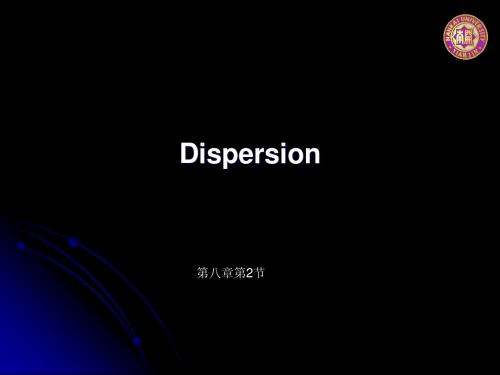
—— Range Instrumentation prism, right.
BM 60 90 right
Ray Tracing
Reflection from Flat Surface
—— Range Instrumentation prism, left, roof.
BM 100 90 left roof
CR 180 roof
Ray Tracing
Reflection from Flat Surface
—— Rhomb prism. It has two reflective faces 斜方棱镜,又名菱形棱镜
BC 0 (Rhomb)
Ray Tracing
Reflection from Flat Surface
Reflection from Flat Surface
—— Isosceles prism, three reflective faces, roof
CR 45 roof (Schmidt)
Ray Tracing
Reflection from Flat Surface
—— Isosceles prism, three reflective faces, roof
Reflection Prism
—— Isosceles prism (Classification code: R), single reflective face. 等腰棱镜(代号:D), 一次反射型
The Dove Prism (AR45)
Ray Tracing
Reflection from Flat Surface
• In fact, if the UV and IR are included, most any substance will sow some absorption. So anomalous dispersion exist somewhere throughout the spectrum
BM 60 90 right
Ray Tracing
Reflection from Flat Surface
—— Range Instrumentation prism, left, roof.
BM 100 90 left roof
CR 180 roof
Ray Tracing
Reflection from Flat Surface
—— Rhomb prism. It has two reflective faces 斜方棱镜,又名菱形棱镜
BC 0 (Rhomb)
Ray Tracing
Reflection from Flat Surface
Reflection from Flat Surface
—— Isosceles prism, three reflective faces, roof
CR 45 roof (Schmidt)
Ray Tracing
Reflection from Flat Surface
—— Isosceles prism, three reflective faces, roof
Reflection Prism
—— Isosceles prism (Classification code: R), single reflective face. 等腰棱镜(代号:D), 一次反射型
The Dove Prism (AR45)
Ray Tracing
Reflection from Flat Surface
• In fact, if the UV and IR are included, most any substance will sow some absorption. So anomalous dispersion exist somewhere throughout the spectrum
大学光学L绪论PPT学习教案

解: 水相对于空气的折射率为 n (n 4 / 3)
根据折射定律,有
O
y' y
Q'
x
i2
i1 M
空 气
水
n1 sin i1 sin i2
Q
y x tan i1
y' x tan i2
y' y tan i1 y sin i1 cos i2 y 1 n2 sin2 i1
tan i2 sin i2 cos i1
第18页/共47页
5)光强定义为一个平均值的原因
响应时间:能够被感知或被记录所需的最短时间 人眼的响应时间:t 0.1s
109 s 最好的仪器的响应时间大约:
T 1015 s
光波的振动周期:t T
人眼和接收器只能感知光波的平均能流密度 有实际意义的是光波的平均能流
第19页/共47页
三、光 谱
n1;n2
第30页/共47页
n1 sin i1 n2 sin i2
斯涅尔定律(W.Snell )
介质折射率不仅与介 质种类有关,而且与光 的波长有关。在同一种 介质中,长波折射率小 ,短波的折射率大。
第31页/共47页
[例题1] 在水中深度为y 处有一发光点Q,作QO垂直于水面,求射
出水面折射线的延长线与QO交点Q '的深度 y 与' 入射角 i1 的关系
1)单色光:仅有单一波长的光叫单色光,否则 是非单色光。
2)谱密度: dI ~ d i() dI
d
3)光谱:谱密度随波长变化的分布曲线
I 0 dI 0 i()d
4)连续光谱:光谱随波长的变化分布连续叫做
连续光谱
第20页/共47页
南开大学光学工程内部课件Sep_16th
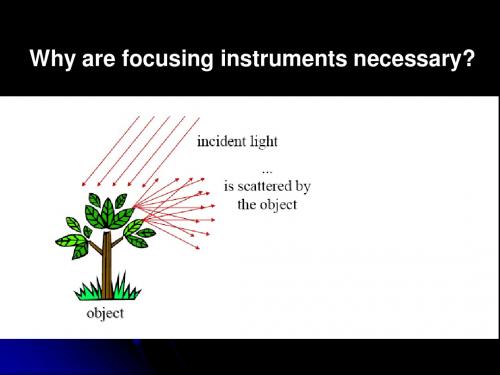
Refraction at curved surface
Similar, the second or image focus is the axial point Fi where the image is formed when S0= . And the second or image focal length fi as equal to Si in the special case, we have
Why are focusing instruments necessary?
Refraction at curved surface
Imaging In order to image S at location P, the time it takes for each and every portion of a wavefront leaving S to converge at point P must be identical. So:
which followed with
n1 n2 1 n2 S i n1 S0 ( ) SM 2 MS ' R MS ' SM
Refraction at curved surface
Discussion Sign convention for spherical refraction surfaces and thin lenses
Refraction at curved surface
Fermat’s Principle maintains that the optical path length (OPLSS’) will be stationary (实际上,物与像之间根据费马原 理具有等光程性), i.e.:
南开大学结构化学课件1.pdf

普朗克因提出量子化概念获得1918年Nobel物理奖。
Nankai University
黑体辐射研究中理论发展过程
实验数据
黑体模型 Kirchhoff 经典理论
经验关系式 Wien
数学模型
众多实验 证明
量子力学 诞生
量子假说 Planck
Planck 数学模型
Rayleigh-Jeans 数学模型 紫外灾难
“The more important fundamental laws and facts of physical science have all been discovered, and these are now so firmly established that the possibility of their ever being supplanted in consequence of new discoveries is exceedingly remote.... Our future discoveries must be looked for in the sixth place of decima”
麦克斯韦尔(J. C. Maxwell) 1856-1865年 电磁理论 光是一种电磁波。
赫兹(Gustav Hertz) 1887 年,实验验证电磁波
光的波动说似乎已确定无疑
Nankai University
1. 麦克斯韦尔电磁学说:光是一种电磁波,可以用电场
Nankai University
玻尔1913年基于卢瑟福(Ernest Rutherford)提出的原子模型,综合Planck和
Einstein的量子论,提出了关于原子结构的模型
①经典轨道加定态条件
光学和光子学概述PPT讲稿

• 分波面干涉、分振幅干涉和分振动面干涉。
现在您浏览的位置是第九页,共三十八页。
四、光的衍射
• 1. 基本概念
• ① 衍射定义 • 光绕过障碍物偏离直线传播而进入几何阴影,
并在屏幕上出现光强分布不均匀的现象。
• ② 衍射条件
障碍物的线度和光的波长可以比拟
• ③ 衍射的分类
a. 菲涅耳衍射:近场、求和、点光源。 b. 夫琅和费衍射:远场、积分、平行光。
表2 霾、云和降水天气的物理参数
天气类型
霾M 霾L 霾H 雨M 雨L 冰雹H 积云C.1 云C.2 云C.3 云C.4
N (cm-3) 100 cm-3 100 cm-3 100 cm-3 100 cm-3 1000 m-3 10 m-3 100 cm-3 100 cm-3 100 cm-3 100 cm-3
m 0.827 N A3 / 4
(9)
式中,m为瑞利散射系数(cm-l);N为单位体积中的分 子数(cm-1);A为分子的散射截面(cm2);为光波长 (cm)。
现在您浏览的位置是第二十页,共三十八页。
由于分子散射波长的四次方成反比。波
长越长,散射越弱;波长越短,散射越强烈。
故可见光比红外光散射强烈,蓝光又比红光
现在您浏览的位置是第八页,共三十八页。
三、光的干涉
• 1. 基本概念 • ①光的电磁理论 • 光是某一波段的电磁波, 其速度就是电磁
波的传播速度;可见光在电磁波谱中只占很小 的一部分,波长在 390 ~ 760 nm 的狭窄范围 以内。
• ②相干条件
• 频率相同、振动方向相同、相位差恒定。
• ③干涉的分类
O2
4.7
9.6
从表1不难看出,对某些特定的波长,大气呈现出极为强烈的吸
现在您浏览的位置是第九页,共三十八页。
四、光的衍射
• 1. 基本概念
• ① 衍射定义 • 光绕过障碍物偏离直线传播而进入几何阴影,
并在屏幕上出现光强分布不均匀的现象。
• ② 衍射条件
障碍物的线度和光的波长可以比拟
• ③ 衍射的分类
a. 菲涅耳衍射:近场、求和、点光源。 b. 夫琅和费衍射:远场、积分、平行光。
表2 霾、云和降水天气的物理参数
天气类型
霾M 霾L 霾H 雨M 雨L 冰雹H 积云C.1 云C.2 云C.3 云C.4
N (cm-3) 100 cm-3 100 cm-3 100 cm-3 100 cm-3 1000 m-3 10 m-3 100 cm-3 100 cm-3 100 cm-3 100 cm-3
m 0.827 N A3 / 4
(9)
式中,m为瑞利散射系数(cm-l);N为单位体积中的分 子数(cm-1);A为分子的散射截面(cm2);为光波长 (cm)。
现在您浏览的位置是第二十页,共三十八页。
由于分子散射波长的四次方成反比。波
长越长,散射越弱;波长越短,散射越强烈。
故可见光比红外光散射强烈,蓝光又比红光
现在您浏览的位置是第八页,共三十八页。
三、光的干涉
• 1. 基本概念 • ①光的电磁理论 • 光是某一波段的电磁波, 其速度就是电磁
波的传播速度;可见光在电磁波谱中只占很小 的一部分,波长在 390 ~ 760 nm 的狭窄范围 以内。
• ②相干条件
• 频率相同、振动方向相同、相位差恒定。
• ③干涉的分类
O2
4.7
9.6
从表1不难看出,对某些特定的波长,大气呈现出极为强烈的吸
南开大学光学工程内部课件Oct 28th
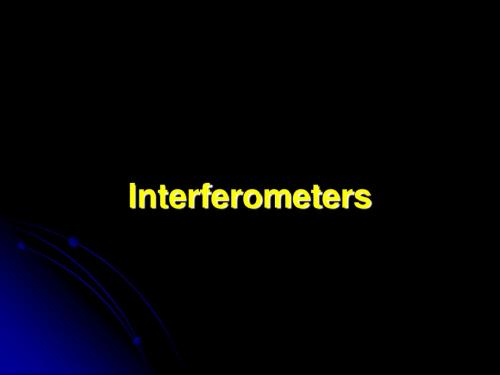
Need Q ~ 105 or greater Led to super mirrors
polished to Angstroms ion beam machining polished to ~ 100 nanometers limited by grit size
Laser gyro developed for aircraft
tCCW = 8R 2c R
Travel time cw
tCW = 8R 2c - R
Time difference
Dt 4 A c2
Number of fringes
DN = 4 A cl
Fringe shift ~ 4 % for 2 rev/sec
Laser gyro
Interferometers
Interferometer
What is interferometer?
Interferometer is the optical setup which split incident light into two beams and then recombines them to create an interference fringe.
N=2L/ l =2L/ l
Phase change (in terms of wavelengths):
DN=Nm - N=2Ln/l- 2L/l= 2L/l (n-1)
The Michelson-Morley Experiment
1881
White light fringes
Adjust the mirrors to make the two path has the same path length, one can see white light fringes.
南开大学光学课件Nov. 23nd
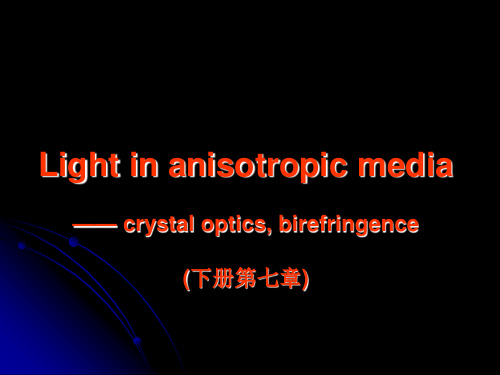
The angle of incidence for which the reflected beam is completely polarized is called the polarizing angle, θp Brewster’s Law relates the polarizing angle to the index of refraction for the material
The horizontal part of the electric field vector in the incident wave causes the charges to vibrate horizontally The vertical part of the vector simultaneously causes them to vibrate vertically Horizontally and vertically polarized waves are emitted
Birefringence
The molecular "spring constant" can be different for different directions.
Birefringence
The x- and ypolarizations can see different refractive index curves.
Birefringence can separate the two polarizations into separate beams
o-ray
no ne
e-ray
Due to Snell's Law, light of different polarizations will bend by different amounts at an interface.
南开大学光学工程内部课件Fresnel diffraction

(6)
(7)
Fresnel approximation for diffraction integral 3/4
The aperture is small compared to both r´ and s´ :
2 2 x 0 y 0 2 x 0 y 0 r r´ 3 r´ 2 r´ 2 r´ 2 2 x y 2 x y s s´ 3 s´ 2 s´ 2 s´
13 13 5 7 Q w 1 2 2 2 4 w w P w 1 1 3 5 1 3 5 7 9 2 2 3 2 5 w w w
We combine (22) into a comblex integral (27)
Fresnel’s integrals 1/7
The integral equation (10) can be written in the form
(12)
U P B C jS ,
(intensity I (P )=|B |2(C 2+S 2))
where (13)
B A C S j
1 2 1 cos r' s' 1 1 r' s'
2
2
2
2
u ,
2
(17)
2
v .
(18)
Then
dd
dudv
1 2 1 cos r' s'
南开大学姚江宏特色大学物理课件光学1-2分振幅薄膜干涉

透射光也有干涉,与反射光干涉的明暗条纹互补。
明环条件 d 1 (2k 1)
4
r (2k 1)R
2
k 1,2,3
暗环条件 d 1 k
2
r kR k 0,1,2,3
22
例2. 牛顿环的应用
C
已知:用紫光照射,借助于低倍测量
显微镜测得由中心往外数第 k 级明环 的半径 rk 3.0 10 3 m , k 级往上数
d 每增加/2:
视场中心外冒一个条纹,视场内条纹 向外扩张,条纹略变稠密.
28
演示工科物理/光的干涉/迈克耳逊干涉仪
(2) 等厚条纹的特征 (M1和M2有一夹角)
若 M1M2 不平行,则d不是常数。若d大时,由于使用的 扩展光源,空间相干性极差, 干涉消失。调小d,出现凸 向空气膜薄边的、弧状的混合型干涉条纹。再调小 d , 使得M1M2 相交,这时出现等厚直条纹。
实际使用中,光线垂直入射;有半波损失。
ZnS的最小厚度 2d1n1 / 2 k
d1
(2k 1)
4n1
|k 1
67.3nm
MgF的最小厚度 2d2n2 / 2 k
n1 n1 n2 n1 n2
n2
d2
(2k 1)
4n2
|k1 114 .6nm
10
练习题: 增透膜和增反膜 为了增加波长为550nm光的透射,在折射率n=1.5的照相 机镜头上涂一层折射率为1.38的氟化镁增透膜。若反射 光相消干涉的条件中取 k=1,膜的厚度为多少?此增透膜 在可见光范围内有没有增反?考虑光线垂直入射。
4
r (2k 1)R
2
k 1,2,3
暗环条件 d 1 k
2
r kR k 0,1,2,3
明环条件 d 1 (2k 1)
4
r (2k 1)R
2
k 1,2,3
暗环条件 d 1 k
2
r kR k 0,1,2,3
22
例2. 牛顿环的应用
C
已知:用紫光照射,借助于低倍测量
显微镜测得由中心往外数第 k 级明环 的半径 rk 3.0 10 3 m , k 级往上数
d 每增加/2:
视场中心外冒一个条纹,视场内条纹 向外扩张,条纹略变稠密.
28
演示工科物理/光的干涉/迈克耳逊干涉仪
(2) 等厚条纹的特征 (M1和M2有一夹角)
若 M1M2 不平行,则d不是常数。若d大时,由于使用的 扩展光源,空间相干性极差, 干涉消失。调小d,出现凸 向空气膜薄边的、弧状的混合型干涉条纹。再调小 d , 使得M1M2 相交,这时出现等厚直条纹。
实际使用中,光线垂直入射;有半波损失。
ZnS的最小厚度 2d1n1 / 2 k
d1
(2k 1)
4n1
|k 1
67.3nm
MgF的最小厚度 2d2n2 / 2 k
n1 n1 n2 n1 n2
n2
d2
(2k 1)
4n2
|k1 114 .6nm
10
练习题: 增透膜和增反膜 为了增加波长为550nm光的透射,在折射率n=1.5的照相 机镜头上涂一层折射率为1.38的氟化镁增透膜。若反射 光相消干涉的条件中取 k=1,膜的厚度为多少?此增透膜 在可见光范围内有没有增反?考虑光线垂直入射。
4
r (2k 1)R
2
k 1,2,3
暗环条件 d 1 k
2
r kR k 0,1,2,3
光学基本知识讲座PPT课件
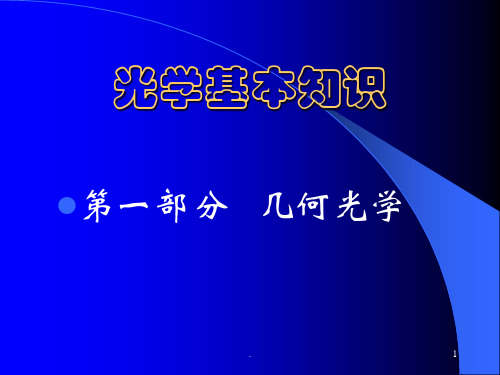
的距离
物方焦距:物方主点到物方焦点
的距离
.
17
3.物像位置、放大率
物像位置:可相对于焦
点或主点来定义
如图所示,
以焦点来定义的物
像公式是:
xx’=ff’
以主点来定义的物
像公式是:
1/l’-1/l=1/f’
.
18
物像位置、放大率
根据上面的成像关系式,可以导出物像 之间放大倍率的计算公式
.
8
三.物像的基本概念
1.光学仪器和激光头 的光学系统都由一系 列折射面和反射面组 成
2.光轴:各个表面的 曲率中心均在同一直 线上的光学系统称为 共轴光学系统,这条 直线称为光轴
.
TOP 66A光 学 系 统 示 意 图 9
物像的基本概念
3.成像:以A为顶点的入 射光束经光学系统一系 列表面折射和反射后, 变为以A’点为顶点的出 射光束,称A为物点,A’ 为像点,A’为物点A的像; 物所在的空间称为物空 间 像所在的空间称为像空 间
反射光线与入射光线 和法线在同一平面内, 入射光线与反射光线 分别位于法线的两侧, 与法线夹角相同
I”=-I
.
7
光的全反射
当光线由光密介质向 光疏介质传播时,根 据折射定律可知,因 n’<n 则 I’>I,当 SinIm=n’/n时,这些 光线不再折射到另一 介质,而按反射定律 在界面上被全部反射
的共轭点必位于该直线的共轭线上。
此假设1841年由高斯建立,故称为高斯光学。
.
14
2.理想光学系统的基点、焦距
平行于光轴的入射光线AE,经 系统后,沿G’F’方向射出, 交于像方F’点,沿光轴入射的 光线经系统后仍沿光轴出射。 由于像方的出射光线G’F’和 OkF’分别与物方的入射光线 AE1和FO1共轭,故像方F’点 在物方的共轭点必是光线AE1、 和FO1的交点,它位于左方无 穷的光轴上,故F’即为无穷远 轴上点的像,称为光学系统 的像方焦点。
- 1、下载文档前请自行甄别文档内容的完整性,平台不提供额外的编辑、内容补充、找答案等附加服务。
- 2、"仅部分预览"的文档,不可在线预览部分如存在完整性等问题,可反馈申请退款(可完整预览的文档不适用该条件!)。
- 3、如文档侵犯您的权益,请联系客服反馈,我们会尽快为您处理(人工客服工作时间:9:00-18:30)。
The objective lens has a short focal length, ƒo<1 cm The ocular lens (eyepiece) has a focal length, ƒe, of several cm L>> ƒo and ƒe
Compound Microscope
The image seen by the eye, I2, is virtual, inverted and very much enlarged
The magnification of the microscope is the product of the magnifications of the objective and the ocular lens
Normal
vision has a far point of infinity
Farsightedness
Also called hyperopia The image focuses behind the retina Can usually see far away objects clearly, but not nearby objects
m o
angle with lens angle without lens
Simple Magnifier
The angular magnification is at a maximum when the image formed by the lens is at the near point of the eye
Presbyopia and Astigmatism
Diopters
Optometrists and ophthalmologists usually prescribe lenses measured in diopters
The
power of a lens in diopters equals the inverse of the focal length in meters
The Eye
The normal eye focuses light and produces a sharp image The f-number of the eye is from about 2.8 to 16 Most of the refraction takes place at the outer surface of the eye
Spherical Aberration
Adaptive optics system
Object
Time-varying atmospheric turbulence
Telescope
Speckle images
Adaptive optics system
Shack-Hartmann wavefront sensor
Optical Instruments
第一章第8节
Optical Instruments
Analysis generally involves the laws of reflection and refraction
Analysis uses the procedures of geometric optics In certain phenomena, the wave nature of light must be taken into account.
m 25 cm f
With a single lens, m may reach 4 without apparent aberrations With multiple lenses, magnifications of up to about 20 can be achieved. Aberration is corrected by the multiple lenses design.
The Camera
The single-lens photographic camera is an optical instrument Components
Box Hold components Converging lens Form a real image Shutter Adjustable Aperture Film Receives the image
Vision
is quit poor if eye immerges in the water
Near and Far Points
The near point is the closest distance for which the lens can accommodate to focus light on the retina
Typically
at age 10, this is about 18 cm It increases with age
The far point of the eye represents the largest distance for which the lens of the relaxed eye can focus light on the retina
This allows the rays to focus on the retina
Presbyopia and Astigmatism
Presbyopia is due to a reduction in accommodation ability
The cornea and lens do not have sufficient focusing power to bring nearby objects into focus on the retina Condition can be corrected with converging lenses
Correcting Nearsightedness
A diverging lens can be used to correct the condition The lens refracts the rays away from the principle axis before they enter the eye
Refracting Telescope
The angular magnification depends on the focal lengths of the objective and eyepiece
Hale Waihona Puke ƒo m o ƒeReflecting Telescope
Replaces the objective lens with a mirror
L 25 cm m Ml Me fo fe
Refracting Telescope
The two lenses are separated by the distance ƒo + ƒe which corresponds to the length of the tube The two lenses are arranged so that the objective forms a real, inverted image of a distant object
第一章第10节
Aberration
First-order theory is no more than a good approximation. An exact ray trace or even measurement performed on a prototype system would certainly reveal inconsistencies with the corresponding paraxial description. Such departures from the idealized conditions of Gaussian optics are known as Aberration
In astigmatism, the light from a point source produces a line image on the retina
Produced when either the cornea or the lens or both are not perfectly symmetric
Simple Magnifier
When the object is placed within the focal length of a converging lens, the lens forms a virtual, erect, and enlarged image Angular magnification
The Eye
Anatomy of eye
Cornea n1.376 blurred vision under water Pupil Adjustable aperture The crystalline lens Gradient index lens n=1.406 for inner core n=1.386 for cortex Retina Adjustable receiver Adjusting time: 15min.
This allows the rays to converge and focus on the retina
Compound Microscope
The image seen by the eye, I2, is virtual, inverted and very much enlarged
The magnification of the microscope is the product of the magnifications of the objective and the ocular lens
Normal
vision has a far point of infinity
Farsightedness
Also called hyperopia The image focuses behind the retina Can usually see far away objects clearly, but not nearby objects
m o
angle with lens angle without lens
Simple Magnifier
The angular magnification is at a maximum when the image formed by the lens is at the near point of the eye
Presbyopia and Astigmatism
Diopters
Optometrists and ophthalmologists usually prescribe lenses measured in diopters
The
power of a lens in diopters equals the inverse of the focal length in meters
The Eye
The normal eye focuses light and produces a sharp image The f-number of the eye is from about 2.8 to 16 Most of the refraction takes place at the outer surface of the eye
Spherical Aberration
Adaptive optics system
Object
Time-varying atmospheric turbulence
Telescope
Speckle images
Adaptive optics system
Shack-Hartmann wavefront sensor
Optical Instruments
第一章第8节
Optical Instruments
Analysis generally involves the laws of reflection and refraction
Analysis uses the procedures of geometric optics In certain phenomena, the wave nature of light must be taken into account.
m 25 cm f
With a single lens, m may reach 4 without apparent aberrations With multiple lenses, magnifications of up to about 20 can be achieved. Aberration is corrected by the multiple lenses design.
The Camera
The single-lens photographic camera is an optical instrument Components
Box Hold components Converging lens Form a real image Shutter Adjustable Aperture Film Receives the image
Vision
is quit poor if eye immerges in the water
Near and Far Points
The near point is the closest distance for which the lens can accommodate to focus light on the retina
Typically
at age 10, this is about 18 cm It increases with age
The far point of the eye represents the largest distance for which the lens of the relaxed eye can focus light on the retina
This allows the rays to focus on the retina
Presbyopia and Astigmatism
Presbyopia is due to a reduction in accommodation ability
The cornea and lens do not have sufficient focusing power to bring nearby objects into focus on the retina Condition can be corrected with converging lenses
Correcting Nearsightedness
A diverging lens can be used to correct the condition The lens refracts the rays away from the principle axis before they enter the eye
Refracting Telescope
The angular magnification depends on the focal lengths of the objective and eyepiece
Hale Waihona Puke ƒo m o ƒeReflecting Telescope
Replaces the objective lens with a mirror
L 25 cm m Ml Me fo fe
Refracting Telescope
The two lenses are separated by the distance ƒo + ƒe which corresponds to the length of the tube The two lenses are arranged so that the objective forms a real, inverted image of a distant object
第一章第10节
Aberration
First-order theory is no more than a good approximation. An exact ray trace or even measurement performed on a prototype system would certainly reveal inconsistencies with the corresponding paraxial description. Such departures from the idealized conditions of Gaussian optics are known as Aberration
In astigmatism, the light from a point source produces a line image on the retina
Produced when either the cornea or the lens or both are not perfectly symmetric
Simple Magnifier
When the object is placed within the focal length of a converging lens, the lens forms a virtual, erect, and enlarged image Angular magnification
The Eye
Anatomy of eye
Cornea n1.376 blurred vision under water Pupil Adjustable aperture The crystalline lens Gradient index lens n=1.406 for inner core n=1.386 for cortex Retina Adjustable receiver Adjusting time: 15min.
This allows the rays to converge and focus on the retina
